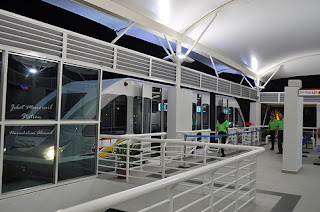The are many interesting place one can mingle in Malacca especially the historical sites which most of it can be found within walking distance.
Malacca's Sultanate Palace
Built based on the description and reference to the palace in 'Sejarah Melayu(the Malay Annals), the wooden replica houses the Cultural Museum of Malacca. Situated at the foot of St. Paul 's Hill, it is the only Malay palace from Malacca's glorious past of the sultanate era built with such detail and refinement.
Mosque
Tranquerah Mosque
The mosque is unique and bears testimony to the fact that Islam had its rightful place in Malacca almost 600 years ago. Was built in 1728, is one of the oldest mosques in Melaka. It was renovated in 1890 and 1910, and is unusual in having a rectangular shape and a three-tier roof -- a pagoda-like structure -- instead of minarets.
Kampung Keling Mosque
The Kampung Keling Mosque is a Sumatran-style building with a three-tiered wooden roof. The mosque was built in 1748 and the outer wall was completed in 1868. The styling of the building is highly eclectic. It is one of the few mosques with a pagoda instead of a minaret. Also, the interior has no dome, which is very unusual. The arcade around the prayer hall is a series of Corinthian columns, reflecting European influence
This mosque was built in 1782 is also during the Dutch rule and can be considered one of the oldest mosque

A'Famosa
It was build by the Portuguese as a fortress after Malacca fall onto their hand in 1511. It sustained severe structual damage during the Dutch attack on Malacca and would have been completely demolished by British if not for the timely intervention of Sir Stamford Raffles in 1808 and that remains of it today.
Stadhuys
This building is a testimony of fine Dutch architecture. Build in 1650 as the official residence of Dutch Governors and administration center, is the oldest Dutch building in the East.
Churchs
St. Paul's Church
Built by the Portuguese in 1521 was formerly a chapel and it was named as “Nosa Senhora” – Our Lady of the Hill.
St. Peter's Church The Christ Church
This church was constructed in 1710 during the Dutch period and it is situated outside the administrative and trading centre of old Dutch Malacca.
This church was built in 1753 and
still stand majestically
St. Francis Xavier's Church
Located at Jalan Laksamana, right in the middle of the historical city of Malacca, was built in 1856, in honour of St. Francis Xavier, a prominent 16th-century Catholic missionary.
St. John Fort
 Rebuilt by the Dutch during the third quarter of the 18 th century, the fort was once a private Portuguese chapel dedicated to St. John the Baptist. The fort has an interesting feature in that its gun embrasures face inland as during that time, attacks on Malacca came mainly from the hinterland instead of from the sea.
Rebuilt by the Dutch during the third quarter of the 18 th century, the fort was once a private Portuguese chapel dedicated to St. John the Baptist. The fort has an interesting feature in that its gun embrasures face inland as during that time, attacks on Malacca came mainly from the hinterland instead of from the sea.Flor de la Mar
The replica of the Portuguese carrack that sank off the coast of Malacca after conquering Malacca and with a huge booty.
The Queen Victoria Fountain
It was built in 1904 by the British to commemorate Her Majesty’s Diamond Jubilee and it still stands elegantly until this very day. The fountain is one of the last traces of British colonial era in Malaysia.
The Proclamation of Independence Memorial
The Proclamation of Independence Memorial was built in 1912. Visitors will be able to view a collection of exhibits – displayed in chronological order and divided into several sections – including manuscripts, videotapes and other audio and visual collections which all document Malaysia’s struggle to achieve its independence from the British colonial rule.




























